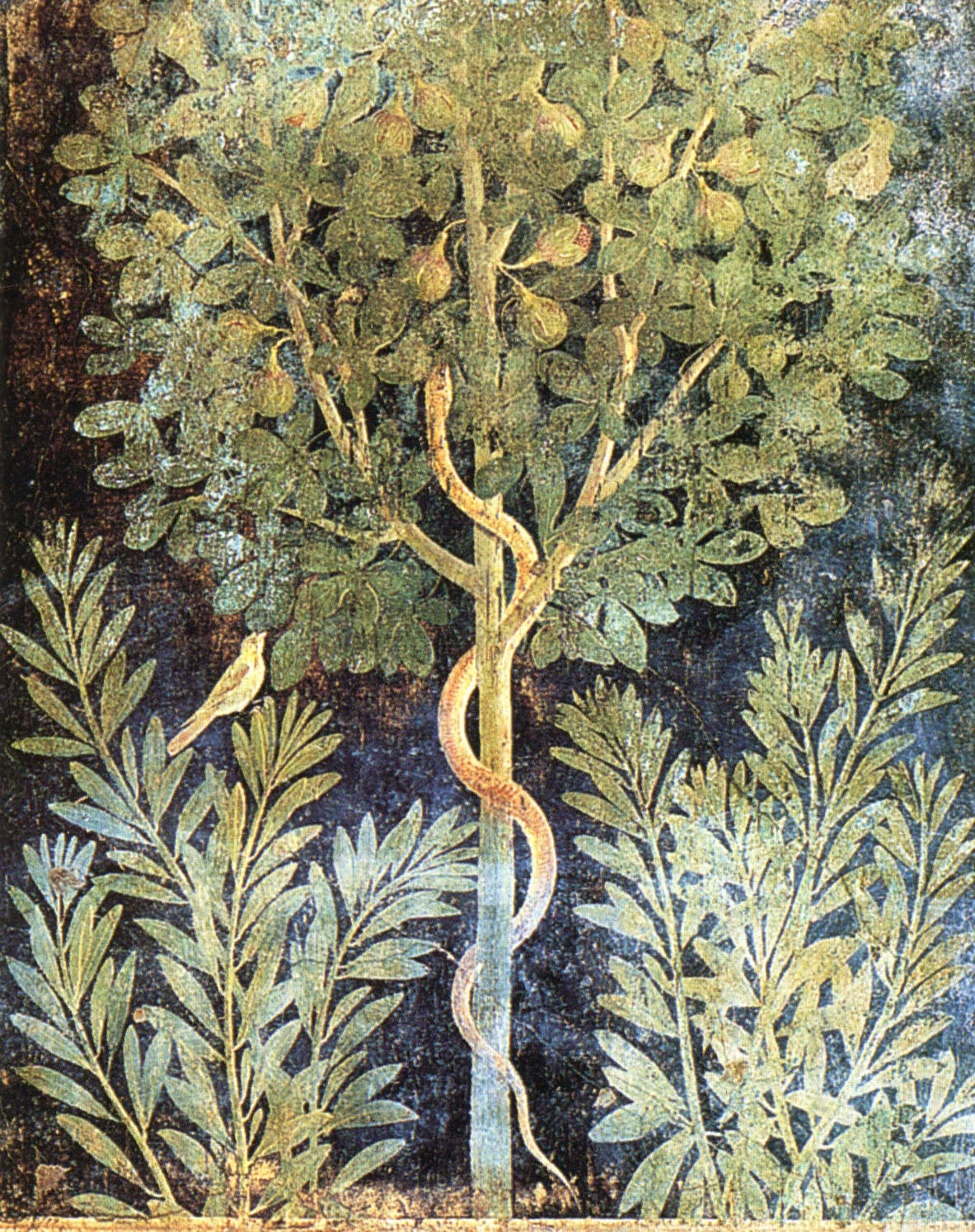 The Jewish Review of Books article by Philip Getz that inspired this poem is illustrated by a fresco from ancient Pompeii, depicting a snake like the one in the Garden of Eden entwined in a fig tree, causing me to wonder whether the possibly Jewish artist was denying that Pompei was the site of the primal pomme, and named Pompeii for this reason, maintaining that the fruit was not an apple but a fig.
Serpent in fig tree. Roman fresco (3rd style) from the Casa del Frutteto (I 9, 5) in Pompeii. Photo by WolfgangRieger/Public Domain
The Jewish Review of Books article by Philip Getz that inspired this poem is illustrated by a fresco from ancient Pompeii, depicting a snake like the one in the Garden of Eden entwined in a fig tree, causing me to wonder whether the possibly Jewish artist was denying that Pompei was the site of the primal pomme, and named Pompeii for this reason, maintaining that the fruit was not an apple but a fig.
Serpent in fig tree. Roman fresco (3rd style) from the Casa del Frutteto (I 9, 5) in Pompeii. Photo by WolfgangRieger/Public Domain Whether the forbidden fruit
really was a tasty apple
is a question, although moot,
with which a lot of scholars grapple.
The fact that in Old French the word
for every fruit was “pom” became
the word for “apple,” may have blurred
the Hebrew word for it, the name
“p’ri” Frenched “apple”. This occurred,
allegedly, around the year
twelve hundred C.E., but I dig
a fruit that to me would appear
more likely and more juicy: fig,
fruit growing on a tree. Its leaves
God used to clothe the naked sinners,
both Eve and Adam, primal thieves
whose fatal flaws were figgy dinners.
The Bible Author blames a snake,
and there’s a fresco in Pompeii
that mug-shots one for this mistake,
depicted climbing a fig tree,
serpent decorating, I presume,
a Jewish house before Vesu-
vius erupted, causing doom,
early era of Jesu.
In “Fruit of the Fall,” JRB, Fall 2023, reviewing Temptation Transformed: The Story of How the Forbidden Fruit Became an Apple by Azzan Yadin-Israel, Philip Getz writes
Back in 1997, a horticulturist at Washington State University named Bruce Barritt placed pollen from a Honeycrisp on the stigma of an Enterprise apple flower. Twenty-two years of testing later the Cosmic Crisp apple was released, to great acclaim. The New York Times described it as “dramatically dark, richly flavored and explosively crisp and juicy,” almost sinfully good, one might say.
This wasn’t the first time apples burst cosmically onto the cultural scene. In twelfth-century France, apples began showing up in Christian depictions of “the Fall of Man,” everywhere from the Cathedral of Notre Dame to illuminated Bibles and psalm books. These red and gold apples supplanted the previous identification of grapes and figs as the forbidden fruit with which the serpent tempted Eve and Eve tempted Adam. Grapes and figs are low-hanging fruit, biblically speaking. The Land of Israel, for instance, is described as “a land of wheat and barley, of vines, figs, and pomegranates, a land of olive trees and honey” (Deut. 8:8)—but not of apples, not here or anywhere else in the Bible. Where did they come from? This is the central question of Azzan Yadin-Israel’s scrumptious scholarly morsel of a book, Temptation Transformed…..
As Yadin-Israel has already shown us earlier, figs and grapes are almost natural choices, given their ubiquity in the Bible, the association of grapes and wine with sin, and the place of fig leaves in the story. The entrenched ecclesiastical tradition identifying these fruits with the Fall would, arguably, be enough to keep them in the picture(s) even in lands to which they were not agriculturally suited. Regardless, Yadin-Israel is a master of philological and iconographic detective work, and the joy of this beautiful little book is in following his reasoning as he thinks through words (in a daunting number of languages) and images.
Much as Rashi did in the very time and place in question, Yadin-Israel eventually finds answers in the Old French. The generic word for fruit in Old French, pom, derives from the Latin pomum, which had been the Latin word commonly used to translate the similarly generic Hebrew peri. But in the twelfth century pom began specifically to designate apples. French readers of the Latin then projected this new meaning of pom onto its linguistic ancestor pomum, thereby transforming the generic fruit into their vernacular pom: a tempting apple.
Gershon Hepner is a poet who has written over 25,000 poems on subjects ranging from music to literature, politics to Torah. He grew up in England and moved to Los Angeles in 1976. Using his varied interests and experiences, he has authored dozens of papers in medical and academic journals, and authored “Legal Friction: Law, Narrative, and Identity Politics in Biblical Israel.” He can be reached at gershonhepner@gmail.com.























 More news and opinions than at a Shabbat dinner, right in your inbox.
More news and opinions than at a Shabbat dinner, right in your inbox.